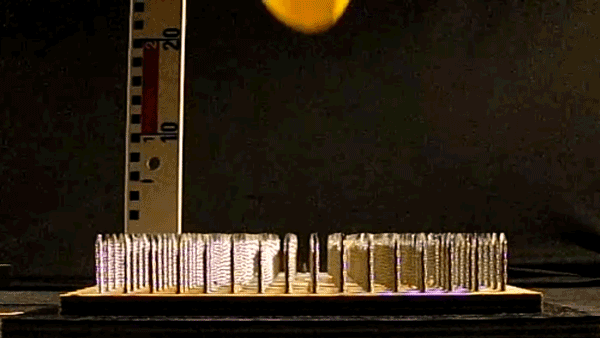Is it possible to bounce a water balloon off a bed of nails? Surprisingly, yes.
In a study published this month in The European Journal of Physics, scientists dropped water balloons on a grid of 256 nails and filmed them bouncing off in slow motion.
What’s the point, you ask? In this GIF science lesson, we learn about the pancake bounce effect and how making tiny things giant can sometimes make them easier to comprehend.

Researchers demonstrated in a slow-motion recording how a water balloon hitting a bed of nails responded with a “pancake bounce.” The video pauses at the moment the balloon achieves the pancake-like state. Moevius, et al.
Tina Hecksher, a physicist at Roskilde University in Denmark assigned this task as a project for some of her students after learning how water droplets bounced off super-water-repelling surfaces in a 2014 study by Julia Yeomans, a physicist at the University of Oxford, and her colleagues.
Normally, a drop of water hitting a flat, repellent surface at low speed will deform slightly and return to its original shape before bouncing. At higher speeds, the drop will flatten like a pancake then retract into a cigarlike shape before leaving the surface. But when microscopic spikes or some other structure is added to the surface, the water droplet undergoes what physicists call maximal deformation and ends up spending less time on the surface. It flattens like a pancake when it lands, then bounces and doesn’t have time to retract until it’s up in the air.
“It’s a quite counterintuitive bounce,” Dr. Hecksher said. “You come down, you spread out, and then you jump off immediately after spreading out without retracting.” It would be like jumping off a table, landing in a flat squat and then bouncing back up still in the squat position.
“Pancake bouncing,” as it was called in the 2014 study, was made possible when the water, held together by surface tension, interacted with those tiny spikes, or microstructure. During impact, some of the water from the droplet is forced in between the spikes, but is ejected quickly by an additional water-repellent coating. The idea can be seen in nature: When water hits a hairy lotus leaf, it beads up and rolls off. It’s called a superhydrophobic surface.
To make this phenomenon easier to fathom, Dr. Hecksher and her students substituted a balloon drop for a water droplet. When the water balloon hit the surface, it underwent the same shape changes as the tiny water droplet. But this time the balloon’s rubber membrane held the water together, not surface tension.
“The mechanisms are slightly different, but the physics is the same,” Dr. Hecksher said.
This scaling tactic isn’t new to physics, which strives to understand how different systems behave similarly — like how an atom’s electrons behave like planets orbiting the sun. By making tiny things giant, Dr. Hecksher and her students produced observations and measurements that couldn’t easily be made at the microscopic level.
You can do it too, although you’ll need a slow-motion camera if you want to see a pancake bounce in action.
Start by filling balloons from a party-supply store with water. Try different balloon sizes and fill them with varying amounts of water. Then make your bed of nails. You want it to be big enough so that when the balloon flattens like a pancake, the large number of nails will support its whole surface. Too few nails, and your balloon is more likely to break.
Next, drop your balloon over the nails from different heights. The researchers started at 20 centimeters above the nails, and worked their way up by that increment until they reached 1.5 meters, or about five feet. After that, the force was too much, and the balloons broke.
A word of caution before getting too excited: This won’t work every time. Balloons should have a uniform thickness, but some don’t. The inconsistent ones will most likely pop, as you can watch at the end of the researchers’ YouTube video.
Source: https://www.nytimes.com/
Dear User/Visitor! Please, answer on our questions: tick off one of the positions – your answer will make us able to improve our site and make it more interesting and useful!

